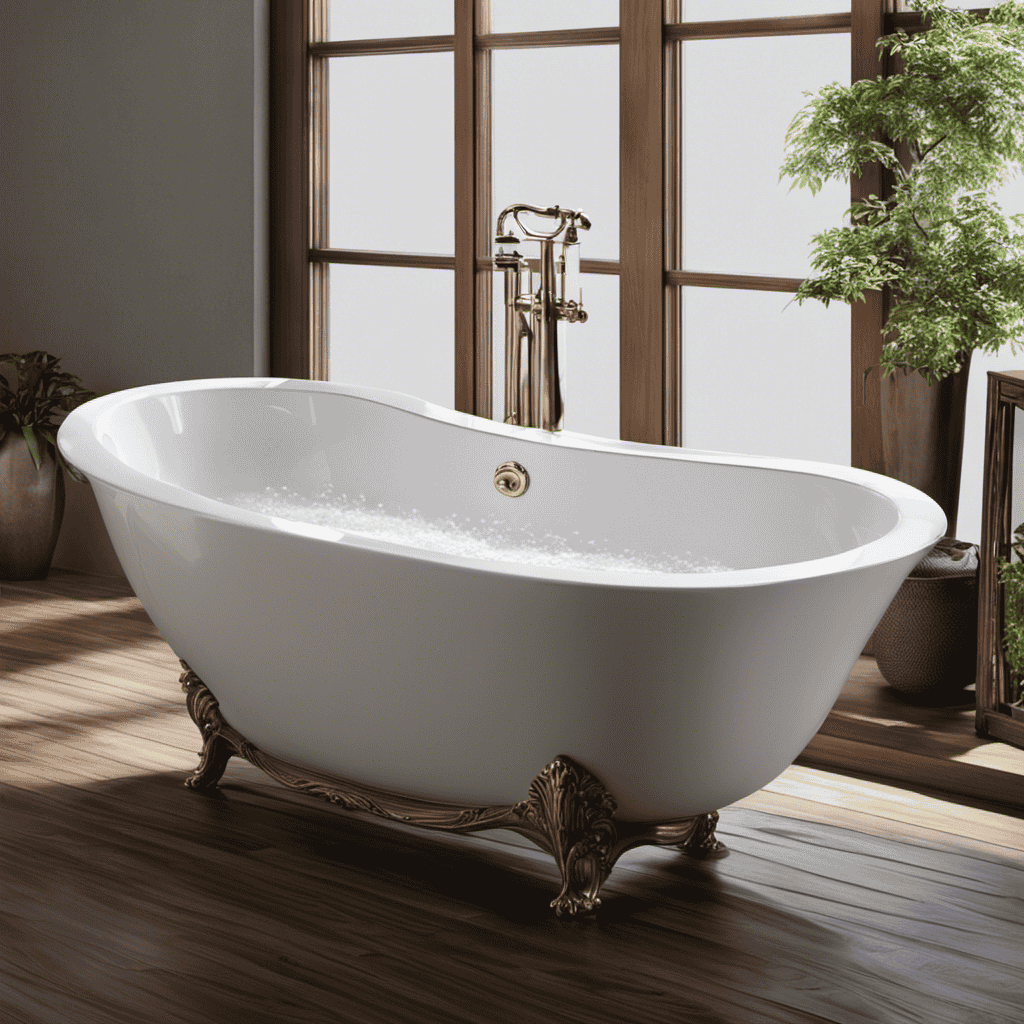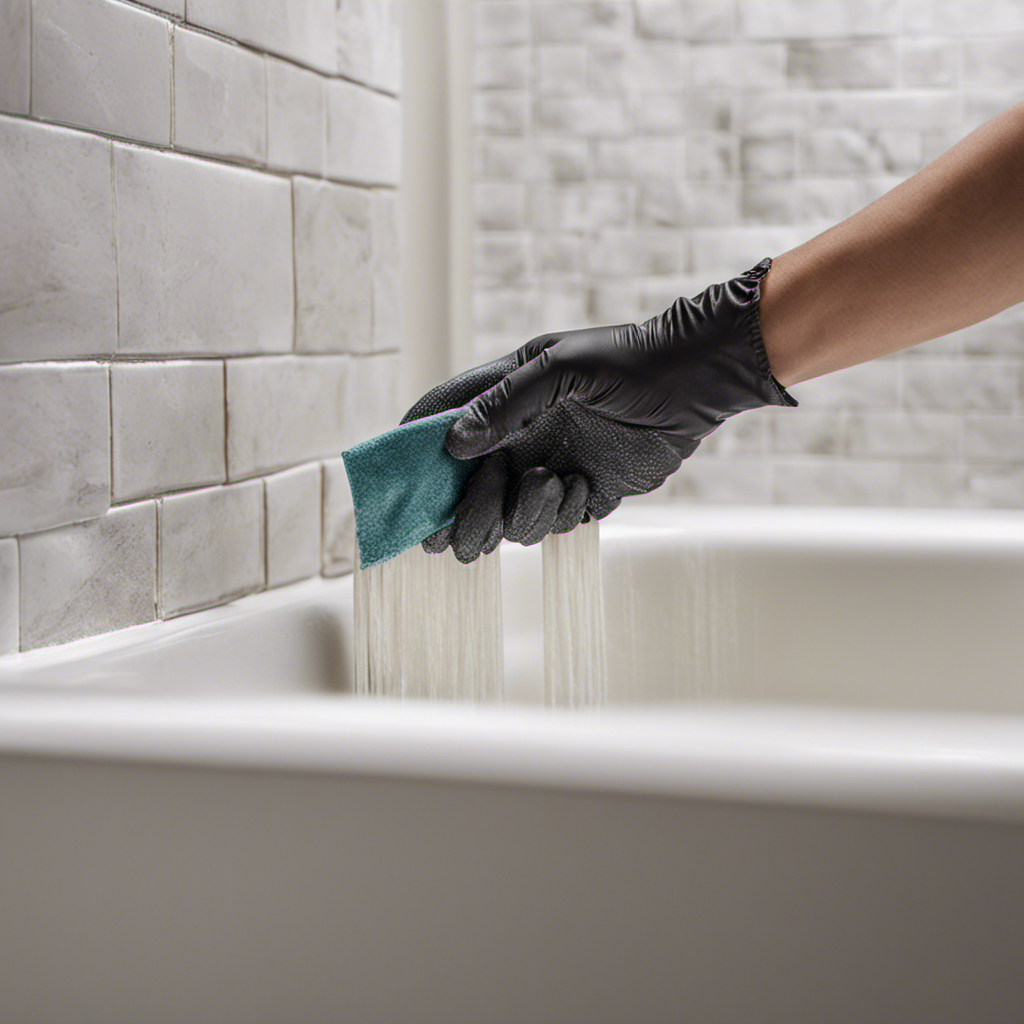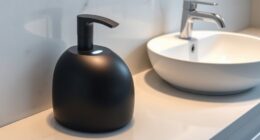I’ve always wondered how many gallons are in a standard bathtub. It’s a question that might seem trivial, but for anyone interested in water conservation or planning a bathroom renovation, it’s essential information.
In this article, we’ll explore the average bathtub size, how to calculate bathtub capacity, and the factors that can affect it. We’ll also provide common gallon measurements for bathtubs and offer tips for accurately measuring bathtub capacity.
So, let’s dive in and unravel the mystery of bathtub gallons!
Key Takeaways
- A standard bathtub typically holds around 40-60 gallons of water.
- The dimensions of a tub, including size and shape, determine its capacity.
- Larger and deeper tubs generally hold more water than smaller and shallower ones.
- The material used to construct the bathtub can also impact its volume.
Average Bathtub Size
A standard bathtub typically holds around 40-60 gallons of water, so you’ll have plenty of space to relax and unwind.
When it comes to measuring bathtub depth, there are various types of bathtubs available in the market.
The most common type is the alcove bathtub, which is designed to fit into a three-wall enclosure. These bathtubs usually have a depth of 14-18 inches.
Another popular option is the freestanding bathtub, which stands alone and can be placed anywhere in the bathroom. These bathtubs come in different depths ranging from 15-24 inches.
The third type is the corner bathtub, which is designed to fit into a corner of the bathroom. These bathtubs typically have a depth of 18-23 inches.
Calculating Bathtub Capacity
To calculate the capacity of a typical tub, you can use a simple formula. First, measure the length, width, and depth of the tub in inches. Multiply these three measurements together to find the volume in cubic inches. Next, divide the volume by 231 to convert it to gallons.
Here are three reasons why knowing the capacity of your bathtub is important:
-
Water Displacement: Understanding the capacity of your tub allows you to calculate how much water will be displaced when you fill it up. This can help you determine if your water heater can handle the demand or if you need to adjust the temperature settings.
-
Proper Filling: Knowing the capacity ensures you don’t overfill the tub, preventing any potential damage or water overflow.
-
Converting Liters to Gallons: If you have a tub with a capacity listed in liters, knowing how to convert liters to gallons can help you understand the true capacity and make accurate comparisons when shopping for a new tub.
Factors Affecting Bathtub Volume
One important factor that affects the volume of a tub is its dimensions. The size and shape of a bathtub play a significant role in determining its capacity. A larger and deeper tub will generally hold more water compared to a smaller and shallower one.
Additionally, the type of material used to construct the bathtub can also impact its volume. For example, acrylic and fiberglass tubs tend to have thinner walls, which means they can accommodate more water. On the other hand, cast iron and solid surface tubs have thicker walls, resulting in a slightly smaller water capacity.
Therefore, when considering the size of a bathtub, it is crucial to take into account both the dimensions and the material used in its construction.
Common Gallon Measurements for Bathtubs
The most common measurements for tubs are 5, 6, and 7 feet in length. These measurements are based on the standard size of bathtubs available in the market.
When it comes to bathtub materials, there are several options to choose from, including acrylic, fiberglass, cast iron, and porcelain. Each material has its advantages and disadvantages in terms of durability, maintenance, and cost.
In addition to different materials, bathtubs also come in various shapes such as rectangular, oval, corner, and freestanding. The shape of the bathtub can affect its overall capacity and water usage. For example, rectangular tubs tend to have greater water capacity compared to oval or corner tubs.
Understanding the different bathtub materials and shapes is important when it comes to measuring bathtub capacity accurately.
Now, let’s move on to some tips for measuring bathtub capacity.
Tips for Measuring Bathtub Capacity
When measuring a tub’s capacity, it’s important to consider the shape and material of the tub. Different shapes and materials can affect the amount of water a bathtub can hold. To accurately measure bathtub dimensions, you will need a measuring tape and a calculator. Measure the length, width, and depth of the tub, making sure to account for any irregularities in shape. Once you have the measurements, you can calculate the capacity using the formula: capacity = length x width x depth. To convert the capacity from liters to gallons, multiply the capacity by 0.264. For example, a bathtub with a capacity of 150 liters would be approximately 39.6 gallons. Remember to consider the shape and material of the tub to get an accurate measurement.
| Length (cm) | Width (cm) | Depth (cm) |
|---|---|---|
| 150 | 75 | 50 |
Conclusion
Well, there you have it, folks. After diving into the world of bathtubs and gallons, we’ve come to a rather enlightening conclusion.
It turns out that determining the capacity of a standard bathtub is not as simple as it seems. From measuring the dimensions to considering factors like depth and shape, it’s a real mathematical feat.
But fear not, for armed with the knowledge of common gallon measurements and some handy tips, you’ll soon be able to calculate your bathtub’s capacity like a pro.
So go forth, my friends, and may your baths be filled with just the right amount of water.










